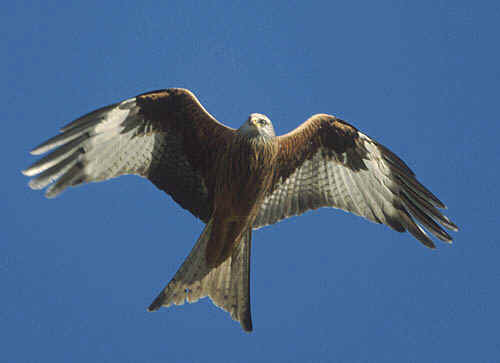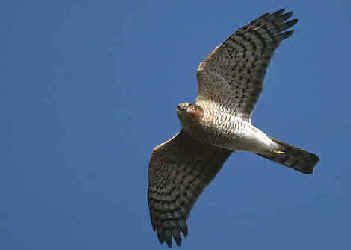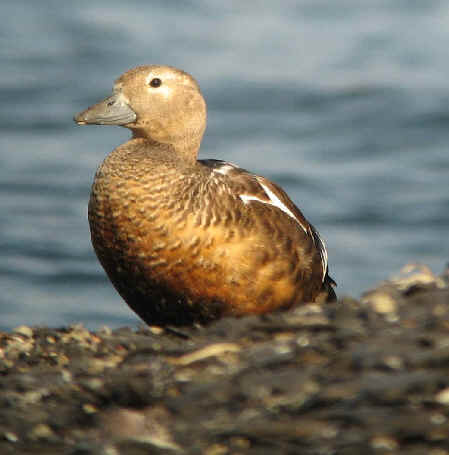
E-mail: font@focusonnature.com
Phone: Toll-free in USA 1-888-721-3555
or 302/529-1876
 |
PO Box 9021,
Wilmington, DE 19809, USA E-mail: font@focusonnature.com Phone: Toll-free in USA 1-888-721-3555 or 302/529-1876 |
THE
FONT BIRDING & NATURE TOUR IN SWEDEN
September 2006

Two of the
raptors seen in their migration at Falsterbo
during our Fall '06 Sweden Tour
were the Red Kite (above)
and the Eurasian Sparrowhawk (below).

Links:
List of Birds during our Sweden Tour - September '06
Cumulative List of Birds during our Sweden Tours
A List & Photo Gallery of European Birds, in 2 Parts
Upcoming FONT Birding & Nature Tours in Sweden
The following written by Armas Hill, leader of the tour:
Sweden,
during the southbound fall migration of birds, is a wonderful place to be. There
are birds, and there are birders with whom to share the experience.
At a couple
particular places along the coast, that avian migration can be tremendous.
During our September 23-28, 2006 Sweden
Tour, we about half of our time in each of those two particular places.
One place was the Falsterbo/Skanor area at
the southern tip of Sweden, where birds funnel in as they are about to cross the
Baltic Sea, as they continue their journey
south. The birds there at Falsterbo are of various kinds: RAPTORS, PASSERINE
LANDBIRDS, SHOREBIRDS, and WATERBIRDS.
The other place that we visited for good birding was the long, narrow island of Oland.
That island is in southeastern Sweden, and yes, it is long, over a hundred
miles. Birds in passage on Oland can be anywhere on the island, but it's the
southern tip that's usually the best spot to be, especially early in the
morning.
Oland is a very pastoral place, with farmfields and small villages.
There's very little commercialism. In fact, much of Oland, at least on a clear
day, looks like a post card, with very clean-looking houses, barns, and stone
fences. Though the island overall looks like a post card, rather ironically
there are not many places there to buy post cards. Stores, even for groceries,
are few and far between. Actually, the best shop for postcards seemed to be a
store (which we assume to be seasonal, during migration time), filled with an
array of bird books and birding optical equipment.
In the fall, Swedish birders
come to Oland from throughout the country, as do other birders from some
various, mostly European, countries. We met many birders when we were in Sweden,
mostly Swedish, but also other Scandanavians, Dutch, British, and probably
others. However, we met no other birders from North America.
We did, however,
actually meet a bird from North America on Oland, a PECTORAL SANDPIPER. It, of
course, was a favorite of the European birders. Word regarding any "good
bird" that appears anywhere on the island spreads fast, as all of the
birders have beepers.
Oland gets "good birds" from the east as well as from the west. Each
year, there are a number of species that normally reside east of western Europe.
During our '06 stay, one such bird we saw was the YELLOW-BROWED WARBLER of
Siberia. We also enjoyed a nicely cooperative RED-BREASTED FLYCATCHER, sallying
for insects from the low branches of a bush - the same bush in which it had been
found a hour or so earlier. In Europe, that species is primarily Russian.
Another bird from eastern Europe that we saw on Oland was a LESSER SPOTTED
EAGLE. It was spotted - by us - as we traveled along a country road.
The Lesser Spotted was not the only eagle for us during our stay on Oland. At
the southern tip of the island, along the coastline, where there were some
shorebirds and many waterfowl, a WHITE-TAILED EAGLE was present. We would see it
either perched on a big rock, or on something else above the fray. When it flew,
so did many other birds.
Especially nice to see at that part of Oland was the large flock of BARNACLE
GEESE that was sometimes at rest on the flats. They came from far-northern
Europe.
And yet another bird from far-northern Europe was at the southern end of Oland
during our tour, that was really good - you might say "steller". With
COMMON EIDERS, either resting on the rocks, or swimming and feeding in the
nearby sea, there was a STELLER'S EIDER! It was a male, although not in adult
breeding plumage. Still, a great bird, and a "new bird", not just for
the FONT Sweden tours, but for FONT European tours overall. There have been 49
FONT birding tours in Europe since 1990. The STELLER'S EIDER at Oland Island,
Sweden in September '06 was bird #437 for FONT in Europe.

A male Steller's Eider in
non-breeding plumage,
photographed during the September 2006
FONT tour in Sweden,
by Claude Bloch
And there were yet other fine birding
moments for us in September '06 on Oland Island. Seeing the COMMON (or EUROPEAN)
CRANES was such a time.
At other times when we'd enter small groves of trees, either by a beach, or near
the lighthouse, there were small birds, often tamely about.
Most often they were
EUROPEAN ROBINS and GOLDCRESTS (dapper little birds similar to American
KINGLETS). Of course, we'd look for other species among them (and would find
some), but it was hard not to continue to look at those tame ROBINS and
GOLDCREST.
The EUROPEAN ROBIN is, of course, smaller than the AMERICAN ROBIN
(and actually a quite different bird). The GOLDCREST is about the smallest of
European birds (with the similar FIRECREST being about the same size).
Having
either the ROBIN or the GOLDCREST in the grass at one's feet, or very closely on
a branch of a bush, is nice indeed. For about the smallest of European birds,
binoculars were not needed.

The European Robin was
seen in numbers
during its migration on the Swedish island of Íland.
With it, also closely and tame were numerous Goldcrests.
Conversely, at other times during the September '06 Sweden tour, and especially
at Falsterbo, the small birds, flying in migration overhead, were so high in the
sky that binoculars hardly helped.
Most species, at some time during the tour,
were seen well, but many times birds such as WOODLARKS and SKYLARKS (aptly
named) were certainly up there. We became somewhat adept at identifying such
birds overhead by their flight calls, but, in all candor, we were not as adept
(nor ever would be) as were the kind Swedish birders who constantly told us what
was calling up the sky beyond the realm of vision.
I should take a moment to explain something in this regard. From the moment we
arrived in Sweden, until the morning of the day that we left, the sky was clear,
nearly always cloudless. For a site in western Europe, that's very unusual for
sure. And because the weather, everyday, was so "good", some of the
bird migration tended to higher.
During our tours at Falsterbo in previous
years, with weather more varied, with more wind and low clouds, many birds were
seen closer to the ground in, for example, bushes at Falsterbo by the greens of
the golf course, or even on the greens themselves. In those bushes, there would
be flocks BLUE TITS and other birds as if they were made on "production
lines" somewhere further north.
On the golf course greens, themselves,
flocks would land of such birds as PIPITS and WAGTAILS and various FINCHES.
In September '06, there were some of these, yes, but not as obviously. A notable
bird that did alight by us in one of the golf course bushes, however, was a
NORTHERN GRAY SHRIKE (in North America, the species is called the NORTHERN
SHRIKE).
A explanatory comment should be given regarding the golf course that's been
referred to. It's at the tip of the peninsula at Falsterbo, where the birds and
birders convene in the fall. In Sweden, due to both custom and law, the golfers
and the birders and the birds all coexist at that golf course during the time of
the bird migration. Respect is given by the birders, who don't enter upon a
green when the golfers are there.
The birds go about their business of migrating
regardless who is there.
RAPTORS are overhead above Falsterbo, sometimes in large numbers. The most
common for us in '06 were, as they would normally be, EURASIAN SPARROWHAWKS and
COMMON BUZZARDS.
Because we were about a week earlier than our other years, we
saw more EUROPEAN HONEY-BUZZARDS. We were too early for Rough-legged Buzzards.
Again, as during our other years, the RED KITES were fun to watch.
During our
September '06 Sweden Tour, other RAPTORS included 2 species of HARRIERS (WESTERN
MARSH & HEN), the 2 species of EAGLES already noted, NORTHERN GOSHAWK,
EURASIAN KESTRELS, MERLIN, PEREGRINE FALCON, and the NORTHERN (or EURASIAN)
HOBBY.
The last of these was a favorite during the tour, particularly when we
watched a group of them flying about in the sky catching dragonflies. The
behavior of the HOBBY is similar to that of the Mississippi Kite in North
America.
The birds called SHOREBIRDS in North America are referred to as WADERS in
Eurasia.
In addition to the American SHOREBIRD, the PECTORAL SANDPIPER, already
mentioned, the WADERS we saw during our '06 Sweden Tour were: EUROPEAN GOLDEN
PLOVER, GREY PLOVER, NORTHERN LAPWING, DUNLIN, RED KNOT, COMMON and SPOTTED
REDSHANKS, COMMON GREENSHANK, COMMON SANDPIPER, RUFF, EURASIAN CURLEW, the
similar and smaller WHIMBREL, and PIED AVOCET.
Not at all a bad assortment, and
it's always nice to see SHOREBIRDS, or WADERS, whichever they're called.
WADERS were among the birds, at times numerous, on the large farm fields
throughout the Swedish region of "Skane". It's a flat region of mostly
farms, with small villages, north of Falsterbo. The countryside there is dotted
with windmills and churches. Some of the fields there, in the fall, can be
covered with birds. We saw some large flocks.
The GULLS favoring fields were the
COMMON and BLACK-HEADED. WADERS included big groups of GOLDEN PLOVERS and
LAPWINGS. On one of the fields, with the PLOVERS, we saw a few birds that
looked, superficially, like large BUFF-BREASTED SANDPIPERS of North America.
They were actually juvenile RUFFS, about to continue on their way further south.
The flocks of SPOTTED REDSHANKS that we saw were also to continue southward, to
either the Mediterranean area, or further south, to Africa.
A flock of KNOTS we saw, along the shoreline at Falsterbo, had come from their
breeding grounds in the High Arctic. That flock would never connect with those
of the same species we see in North America that migrate many miles south to the
end of land in South America (Tierra del Fuego).
But where we saw those KNOTS,
during our Sweden Tour, was close to where the species got its name - just a
relatively few miles across the Baltic in Denmark. "The KNOT was called
CANUTUS (that's still the scientific name), bird of old, of that great king of
the Danes, his name that still doth hold, his appetite to please, that farre and
neare was sought, for him (as some have said), from Denmark hither
brought". Thus, the name of the KNOT. The quote just given was written in
1622.
Our tour in Scandanavia, with KNOTS and all the other birds, written about now,
384 years later in 2006, was an enjoyable experience. Most of our birding, as
has been noted, was in Sweden, but we were also in Denmark, as the tour began
and ended at the airport in Copenhagen.
After this tour on the European mainland, there was another, that followed, in
Iceland. Each year, the FONT Sweden and Iceland Tours in the Fall can be done in
conjunction with each other.
The KNOT was one of 110 species of birds found during our '06 Sweden Tour. A
link to the list is at the beginning of this narrative.
We also saw BUTTERFLIES, notably groups of RED ADMIRALS, Vanessa Atalanta, a
strong flier that's migratory (they say, a northward migrant from Africa), and
some MAMMALS: both GRAY and HARBOR SEALS, and FALLOW DEER. The last of these
were brought from the Mediterranean Region to the southern part of Oland Island,
over 300 years ago, when that location was a royal estate.
The MIGRATION of BIRDS in southern Sweden has been well tracked for many years.
I don't know if that's been so for 300 or more years, but certainly detailed
records, tallying the migrants, have been kept through much of the 20th Century.
In 2006, it was good for us to be there again, with one of the foremost of the
world's BIRD MIGRATIONS. Regardless how many years records of it have been kept,
the MIGRATION there, one can imagine, has occurred as long as there have been
BIRDS flying south every fall.
Top of page